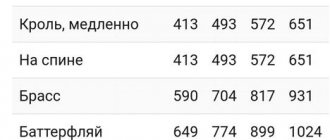Excess body weight worries a huge number of people - they just can’t figure out how to deal with the problem. The vast majority do not even imagine how many calories a person spends per day, but this is precisely the very criterion, a beacon that can be used to guide you in the difficult task of losing weight and getting in shape. Let's figure out together how much energy we need, how much we get from food, and how to organize a deficit that allows you to lose extra pounds.
What are kilocalories and BZHU, their main tasks
A kilocalorie measures the amount of heat released from foods during digestion. One calorie is equal to 4.2 joules - a characteristic of energy level. The body spends this component to maintain vital functions.
One unit of heat gives the same amount of energy. Products differ in the ratio of BJUs, and the digestion of each of these components requires a different amount of energy. Therefore, the part of the heat that the body loses when breaking down food is taken away from the initial calorie content.
The body consumes each element of BJU in its own way:
- Carbohydrates provide 4 kcal. Once in the metabolism, they are converted into glucose and raise blood sugar levels, which gives the body energy to work. Most of this resource is extracted from food and consumed immediately. The body stores the remainder as fat.
- Proteins provide 4 kcal and are broken down into amino acids, which act as builders of tissue and muscles, and also deliver oxygen to cells. The body creates some of the components of this substance on its own. The body does not store protein and receives it only from food; the remains are eliminated naturally.
- Fats provide 9 kcal, are used to protect organs, obtain energy and other body functions. The body constantly stores lipids and spends these reserves last.
The table with dietary volumes shows approximately how many kilocalories a person needs per day, but does not take into account the energy value of food. In order for the energy received by the body to be spent correctly, it is worth adhering to the KBZHU.
Calorie content or balance of BZHU: what is more important:
Diet
In old age, noted Lyudmila Zhilevich, nutrition should be regular, without long “hungry” intervals. It is advisable to divide meals into 4–5 times.
With four meals a day, the number of calories per day is distributed as follows:
- 25% – first breakfast;
- 15% – second breakfast or afternoon snack;
- 35% – lunch;
- 25% – dinner.
With five meals a day, experts recommend dividing the energy requirement as follows:
- 25% – 1 breakfast;
- 15% – 2 breakfast;
- 30% – lunch;
- 20% – 1 dinner;
- 10% – 2 dinner.
For breakfast, you can cook porridge and drink herbal tea. Second breakfast includes a light salad or baked fruit or vegetable. Lunch is more substantial. It can consist of soup, main course, compote (fruit drink). Dinner should be light so as not to overload the digestive system at night, but nutritious. Before going to bed, it would be a good idea to drink fermented baked milk or kefir.
Lyudmila Zhilevich chief freelance gerontologist of the Ministry of Health, head of the Republican Gerontological Center (active longevity):
– It is advisable to choose natural products, with a lesser degree of culinary processing and without various artificial additives. Use greens and herbs. And one more thing: you should not get carried away with exotic foods; it is preferable to eat those vegetables and fruits that are familiar to our body.
If after the age of 75 a person loses his appetite and begins to lose weight quickly, this may be a sign of senile asthenia or pathological aging! By adjusting your diet, this process can be stopped. The main rule: the diet should contain enough protein and vegetable fats.
With age, dental problems can make themselves felt. As a result, older people prefer grated food with a more liquid consistency. This makes chewing easier, but does not put enough stress on the intestines. In this case, Lyudmila Zhilevich advised consuming more greens or dietary fiber as an additional supplement.
Useful and harmful calories
Calories do no harm or good because they are simply a source of heat. This property is carried by energy carriers: fats, proteins and carbohydrates.
Each of these compounds has a different origin and therefore has a specific effect on the body:
- Carbohydrates are divided into fast and slow. The former sharply raise blood sugar, which provokes the body to store excess energy in fat reserves. The latter take a long time to digest due to their complex composition and are gradually consumed by the body. Fast carbohydrates include refined foods, and slow carbohydrates include foods high in fiber.
- Proteins are not harmful, however, their excess is harmful. Some products containing amino acids contain harmful lipids and antibiotics. Fatty meats are not suitable for consumption. Vegetable protein has an inferior composition of amino acids, so it is worth supplementing the menu with a complex of legumes and nuts.
- Fats are divided into saturated and unsaturated. The first type is only conditionally useful for the body, therefore it plays the role of a source of energy, which is consumed last, and therefore put aside in reserve. The body actively uses unsaturated fats to regulate brain function, replenish hormones, protect the skin and other means.
The BJU ratio is calculated individually for specific purposes. If the goal is to increase the percentage of muscle mass and reduce the fat reserve, a menu is selected in which proteins occupy the main place, and fats are not consumed at the same time as carbohydrates.
Daily energy norms - tables
If you are a woman, you are 30 years old, you work in an office and regularly play sports, then your calorie intake will be from 1800 kcal to 2200 kcal. A more accurate figure for calculations using the formula will only be a random choice that does not guarantee additional accuracy.
Among other things, the level of absorption of plant proteins does not exceed 50-70%, and the fiber contained in the products is not absorbed at all (although it is included in the “carbohydrates” column) - that is, the nutritional value indicated on the packaging is considered exclusively mathematical.
Calorie norm table for women
| Age | Activity level | Calorie norm |
| 17 – 40 years | Short | 1800-2000 kcal |
| Average | 2000-2200 kcal | |
| High | 2200-2400 kcal | |
| 41 – 60 years | Short | 1600-1800 kcal |
| Average | 1800-2000 kcal | |
| High | 2000-2200 kcal | |
| Over 61 years old | Short | 1600 kcal |
| Average | 1800 kcal | |
| High | 2000 kcal |
After reaching the age of 40, women's metabolic rate usually decreases. Against this background, a decrease in estrogen levels after menopause leads to a change in the body's sensitivity to carbohydrates - and the associated excess weight gain. On average, women gain from 5 to 7 kg.
// At what age does metabolism begin to slow down?
Calorie norm table for men
| Age | Activity level | Calorie norm |
| 17 – 40 years | Short | 2400-2600 kcal |
| Average | 2600-2800 kcal | |
| High | 3000-3200 kcal | |
| 41 – 60 years | Short | 2000-2200 kcal |
| Average | 2400-2600 kcal | |
| High | 2600-2800 kcal | |
| Over 61 years old | Short | 2000 kcal |
| Average | 2200-2400 kcal | |
| High | 2400-2600 kcal |
Male metabolism is characterized by testosterone levels - this hormone helps maintain muscle mass and burn fat. However, after 30-35 years, testosterone begins to fall - against the background of a sedentary lifestyle and poor nutrition, this leads to the growth of belly fat.
// How to quickly remove belly fat for a man?
Calorie norm table for children and adolescents
| Age | Activity level | Calorie norm |
| 14 years | Short | 1000 kcal |
| Average | 1200-1400 kcal | |
| High | 1400-1600 kcal | |
| 5 – 8 years | Short | 1200-1400 kcal |
| Average | 1400-1600 kcal | |
| High | 1600-1900 kcal | |
| 9 – 11 years | Short | 1500-1800 kcal |
| Average | 1800-2000 kcal | |
| High | 1900-2200 kcal | |
| 12 – 16 years old | Short | 1600-1800 kcal |
| Average | 2000-2500 kcal | |
| High | 2500-3000 kcal |
The reason for the growth of the belly in teenagers is the love of sweets and snacks. Eating children fast carbohydrates (sugar, honey, cornflakes, candies, chocolate) provokes negative hormonal changes, including those related to brain function.
// How can a teenager lose belly fat and pump up his abs?
Standards for women, men and children
The table can show how many kilocalories a person needs per day more clearly. It is worth taking into account that physical activity requires replenishment of additional energy expended during training. In addition, more calories are spent on daily muscle maintenance.
| Group of persons | Need to consume calories per day |
| Children 6 months–3 years | 800–1500 |
| Children 3–11 years old | 1500–2500 |
| Girls and boys 14–17 years old | 2700–3100 |
| Pregnant and lactating women | 3200–3500 |
| Athletes women and men | 4000–5000 |
Using the table above, you can determine with sufficient accuracy how many kilocalories a person needs per day, taking into account his age, gender and physical activity.
This difference between certain groups of people is justified by different physical activities. In addition, pregnant and lactating girls need to increase their diet in order to additionally provide the child with the necessary compounds, as well as replenish the resources expended on this.
The amount of calories in women is slightly less than in men. Age and work environment also affect the amount of energy expended:
| Women age in years/calorie norm | Men age in years / calorie intake | ||||
| 21–26 | 27–50 | >50 | 21–26 | 27–50 | > 50 |
| 1900 | 1700 | 1600 | 2400 | 2100 | 1800 |
The calorie intake is determined by many factors, as well as the BZHU ratio. To calculate them more accurately, you need to use one of the special formulas. And based on the results obtained, you can subsequently adjust your calorie intake.
Don't miss the most popular article in the section: Fashionable haircut for short hair. Photo, front and back views.
How to burn 1000 calories a day
From all that has been said above, we can conclude that to get results it is not at all necessary to destroy mountains and swim across oceans. It is enough to slightly adjust your diet and physical activity for weight loss to begin. Let's figure out how to spend more than you consume using simple tips that will have virtually no impact on your usual schedule and routine.
Oatmeal, sir!
An English breakfast with oatmeal is very healthy if there are no contraindications. But, if you replace two tablespoons of porridge with bran, then its usefulness will increase due to an increase in the amount of fiber that can cleanse the stomach, absorb and remove toxins. Read more about wheat and oat bran on the website.
More protein in the morning
If your breakfast consists of only porridge, you should add some protein to it, which will give you more energy and allow you to “survive” until lunch without much effort. It could be boiled chicken, an egg, a piece of mozzarella cheese.
Dance while you brush your teeth
Many people complain that they don’t have time for a morning jog, gymnastics, or exercises. However, physical activity can be increased completely “painlessly”. This way you can arrange impromptu dances during hygiene procedures; you can turn on music to set the mood. While your morning coffee is brewing, you can squat or do lunges, bends, stretching exercises, and jump on the spot.
Drink clean water
The main champion in calorie content among food products is store-bought juices or sweet carbonated drinks. They contain simply a colossal amount of sugar, which can be considered calories in its pure form. Even those that do not contain sugar contain sugar substitutes, which often causes insulin spikes, disrupting the body’s natural balance. To reduce calorie content and increase consumption, it makes sense to replace all this with ordinary clean water. Additionally, it will saturate the fabrics with moisture, make the skin cleaner, nails and hair stronger.
Proper healthy snacks
For many people, their work schedule does not allow them to eat properly and on time, which can also lead to problems with calorie consumption. After all, people often arrange quick tea parties with the same tasty treats, and in the evening they gorge themselves “to their fullest.” It’s worth giving up buns, cakes, and sandwiches by preparing a healthy snack in advance; recipes are in a separate article.
Active telephone conversation
If you often receive phone calls, especially at work, this can be used to burn calories more actively during the day. Never talk while sitting still. Get up and walk around your office, study, or even go out into the hallway. It may not be much, but it will definitely help.
Good sex is the key to health
It's no joke; having sex more frequently and for longer will help you burn an extra 3.1 calories per minute for women and 4.2 for men. Scientists even calculated that in about 25 minutes you will burn the same amount of energy as you get from eating 100 grams of French fries.
On foot always and always
If you can get to work, school, educational institutions or child care on foot, then be sure to walk. If necessary, adjust your schedule to allow for a few extra minutes so you can be on time everywhere. If this is not possible, you can walk to the store, cinema, or refuse the elevator or escalator.
Why you need to stick to your daily calorie intake
Limiting the amount of food you eat is the main rule for people losing weight. However, most of those who strive to lose weight, after some time, return to their previous shape and look fuller.
The body perceives a strong reduction in calories as a mode of hunger, so it begins to burn muscles and slow down metabolism.
When returning to a normal diet, the body quickly replenishes lost resources and stores reserve fat in case of hunger. When calories are exceeded, the body also inevitably stores excess weight.
Therefore, the only stable state in which the body does not make fat reserves and provides all its functions is following the daily caloric intake and balance of fatty acids.
Lower limits of normal
The table can show how many kilocalories a person needs per day without taking into account individual characteristics that affect metabolism. By making a calculation using special formulas, you can find out your daily calorie intake. To the result obtained, add 200 kilocalories and then subtract 400.
These values are the upper and lower limits of normal. Another way to calculate this data is to subtract or add 10-15% of calories to your basal metabolic rate.
The range within these numbers is called the calorie corridor. This means that changes in daily caloric intake should not go beyond the normal range. Otherwise, the body will begin to slow down its metabolism and weight will stop losing, and energy will be extracted due to the destruction of muscle fibers.
Consequences of insufficient and excess calorie intake
At first, insufficient or excessive calorie intake may not be noticeable.
However, this lifestyle systematically harms the body, which is why the accumulated habit can lead to the following negative consequences:
- decreased immunity;
- eating disorders, such as compulsive overeating;
- disturbances in the gastrointestinal tract;
- oncology;
- disorders in mental and physical development.
In addition to the lack of calories in the diet, their excess gives rise to a lot of problems leading to obesity and accompanying diseases:
- diabetes;
- diseases of the cardiovascular system;
- atherosclerosis;
- disorders in the musculoskeletal system.
It should be understood that the calorie rate for one person may be too high or low for another. Only the volume of reserve fat can tell whether the diet is correct.
Muffin-Jeor formula for calculating daily calorie intake
The number of calories consumed during the day is selected for each individual, since age, height and weight play a role here. To do this, in 2005, scientists Muffin and Jeor jointly developed a formula that takes these factors into account. The next technique is approved by the American Dietetic Association.
In addition, an indicator of regular physical activity is added to the formula, which adds accuracy to the resulting calorie volume.
You can calculate the daily value for women:
GV = 9.9 * weight (kg) + height (cm) * 6.3 – 4.9 * age – 161,
and for men:
GV = 9.9 * weight (kg) + height (cm) * 6.3 – 4.9 * age + 5.
Thus, the calculation for a woman with an age of 23 years, a body weight of 50 kg, and a height of 165 cm can be obtained: 9.9 * 50 + 165 * 6.3 – 4.9 * 23 – 161 = 1256 kcal. Similarly, a 26-year-old man, weighing 70 kg, height 180 cm, will have a requirement of 1535 kcal.
In this case, you need to take into account the component of physical activity. The resulting value is multiplied by the activity coefficient.
The minimum value for sedentary work is 1.2, and for heavy loads with training 2 times a day - 1.9. The level of physical activity in this range changes in steps of 0.1.
Protein Shake Recipes
Cocktail of oranges and bananas
Ingredients:
- orange juice concentrate (250 ml);
- vanilla low-fat yogurt (100 g);
- banana (1 pc);
- six ice cubes;
- milk 1% fat (100 g).
Place all ingredients from the recipe in a blender and blend.
Cocoa cocktail
Ingredients:
- kefir (500 ml);
- cottage cheese (300 g);
- natural cocoa powder without additives (5 tsp);
- water (100 ml);
- sweetener.
How to cook:
- Dilute cocoa powder and sweetener with water, put on fire and bring to a boil;
- Cook for a minute, stirring, then cool. Add the chocolate mixture to the cottage cheese and kefir mixture and beat until smooth;
- Drink chilled.
Soy Protein Shake with Almonds
Ingredients:
- protein (1 scoop);
- soy milk (1 tbsp);
- crushed almonds (1 tsp);
- maple syrup without sugar (1 tsp);
- vanilla extract (3 drops);
- ice;
- Greek yogurt (1 tbsp.)
Mix all the ingredients of the cocktail and blend in a blender.
Harris-Benedict formula
The formula, which is widely used for calculations, was invented in 1991. However, the method is inferior in applicability to other methods. Compared to other formulas, an insufficient number of individual characteristics are used here, which gives a strong error in the calculations - more than 5%. The method does not take into account the indicator of daily physical activity in the calculations.
The formula looks like this:
Female: 655 + (9.5 * weight in kg) + (1.86 * height in cm) – (4.67 * age).
Male: 66.48 + (13.74 * weight in kg) + (5 * height in cm) – (6.75 * age).
Thus, a woman with indicators of 50 kg, 23 years old, 165 cm will need to consume 1332 kcal. A man with initial data of 70 kg, 26 years old, 180 cm needs 1703 kcal to remain at his weight.
Ketch-McArdle formula
This method does not take into account body weight, number of years and growth rate when calculating. Only the individual body fat percentage is included in the expression. The error in calculations based on this coefficient is large.
However, accurate measurements of body fat along with applying the result of the Harris-Benedict formula in calculations will give an indicator with minimal error.
The Ketch-McArdle formula does not require complex calculations and looks like this:
- BM = 371 + 20.59 * a
The last variable refers to the percentage of body fat. It can be measured using special equipment found in hospitals and gyms.
This indicator can also be approximately calculated by dividing the weight in kilograms by the height in meters squared:
- body mass index (%fat) = weight (kg) / height (cm)2.
A data table for certain groups can predict how many kilocalories a person needs per day with an equally large error. However, multiplying the coefficient obtained from the Ketch-McArdle formula by the result of calculation by the Harris-Benedict method will increase the accuracy of the measurements.
For women with parameters of 50 kg, 165 cm and a diet of 1332 kcal, calculated using the previous formula, the basic metabolism will be equal to:
BM=1332*(371+21.61*(50/1.652)) =1021 kcal.
For men with a weight of 70 kg, a height of 170 cm and a daily requirement of 1703 kcal:
BM = 1703 * (371+21.61 * (70/1.702) = 1521 kcal.
This result is more accurate, however, body weight without fat, calculated using the formula, is significantly inferior in error to measurements using special equipment.
Don't miss the most popular article in the section: Fashionable haircut for medium hair. Photo, front and back views.
WHO formula
The World Health Organization (WHO) calorie formula is based on the same principle as the Muffin-Geor method. However, here age is placed in ranges and for each of them an individual calculation is carried out using the physical activity coefficient (PFA).
How many kilocalories a person needs per day is determined using an additional table taking into account the degree of physical activity, where 1 is low, 1.3 is medium, 1.5 is high physical activity.
| Women | OOV | Men | OOV |
| 18–30 years old | (0.062 * weight + 2.0359) * 240*KA | 18–30 years old | (0.063 * weight + 2.895) * 240 * KA |
| 31–60 years old | (0.034 * weight + 3.539) * 240*KA | 31–60 years old | (0.484 * weight + 3.654) * 240 * KA |
| Over 60 years old | (0.038 * weight + 2.756) * 240 * KA | Over 60 years old | (0.491 * weight + 2.458) * 240 * KA |
A man with parameters 27 years old, 70 kg and CFA - 1.3 according to the formula has a coefficient:
(0.063 * 70 + 2.895) * 240 * 1.3 = 2279 kcal.
Formula based on body area
Another name for this method of calculating calories is the Harris-Benedict formula. With the help of such calculations, you can obtain a result as close to reality as possible. The expression contains weight, height and age, and for women and men different initial numbers are used in the calculations.
The percentage of body fat does not appear in the calculations. Therefore, this method will not show accurate results for people who exercise regularly and have large muscle mass. In this case, the basal metabolic rate will be lower than the real one. For overweight people this value will be overestimated.
For men, the daily calorie intake is calculated using the formula:
GV = 66 + (13.699 * weight in kg) + (5 * height in cm) - (6.809 * age in years).
And for women:
GV = 65 + (9.599 * weight in kg) + (1.799 * height in cm) - (4.8 * age in years).
The daily caloric intake coefficient for a man with indicators of 70 kg, 170 cm, 27 years old is:
OOV = 66 + (13.699 * 70) + (5 * 170) - (6.809 * 27) = 1691 kcal.
For a woman with initial data of 23 years old, weight 50 kg, height 165 cm, this figure is equal to:
OOV = 65 + (9.599 * 50) + (5 * 165) - (6.809 * 23) = 1213 kcal.
In addition, the result obtained can be multiplied by the indicator of physical activity. A range is proposed for him, in which 1.2 is low mobility, 1.729 is heavy physical work.
How many calories does the average person burn in one day?
It is believed that the most effective way to reduce body weight is to reduce the amount of calories consumed to a level below that absorbed per day. This is how a deficit is created, which is the main task of anyone who wants to lose weight.
Exercise levels: how many calories does a person burn per day?
When a person is actively engaged in physical labor, walks a lot, devotes time to active recreation and engages in argument, then it is clear how the energy consumed through nutrition is spent. However, if he gets to work by car, and then sits all day at a desk in a dusty office, in the evening he continues to sit idle in front of the TV or with his favorite gadget in his hands, a legitimate question arises - how many calories per day does the average man or woman who leads a similar lifestyle spend? Is it really possible to create at least some kind of calorie deficit in this case?
First of all, you need to figure out how much a person spends just lying on the couch, find out your activity level, which is often used by nutritionists and athletes. To do this, you need to correctly calculate the required number of calories for basic metabolism (BMR) using a special formula, taking into account body weight. Weight in kilograms is multiplied by 20 and the desired result is obtained . For example, a girl weighing 65 kilograms spends at least 1,300 kilocalories per day on breathing, thermoregulation, brain activity, heartbeat and other physiological needs of the body. The resulting amount must be multiplied by a special activity coefficient.
- First type: 1.5 – increased.
- Second type: 1.4 – moderate.
- Third type: 1.3 – average.
- Fourth type: 1.2 – low.
What type you consider yourself to be and how many calories you need to burn per day, everyone must figure out for themselves. So the first and second usually refer to people who regularly engage in sports or physical labor, the third are those who often walk and occasionally exercise and do exercises. The fourth type usually refers to people who lead a sedentary lifestyle and move little.
It is important to understand that when losing weight, your calorie intake calculation must be constantly recalculated, so you can know exactly how many calories to burn per day to lose weight. It is optimal to make new calculations every time you lose 4-5 kilograms.
How much is burned under different types of load?
In addition to ensuring vital functions, everyone performs some kind of movement, be it cooking or cleaning. All these manipulations also consume energy, which cannot be ignored. Here is an approximate table for a person weighing 70 kilograms; more detailed data can be found on our website.
| Kind of activity | Calorie consumption per hour |
| Making the bed | 70 |
| Washing windows, mirrors | 180 |
| Running, games | 175 |
| Ironing | 74 |
| Mopping floors | 170 |
| Washing dishes | 67 |
| Walking with an animal (walking the dog) | 102 |
| Cooking | 210 |
| Watering indoor plants | 88 |
| Shopping in a store (shopping) | 105 |
| Carrying shopping | 178 |
| Cleaning the yard, garage, shed | 140 |
| Active games with children and animals | 170 |
| Jogging | 380 |
| A ride on the bicycle | 220 |
| Handwash | 110 |
| Dream | 46 |
| Reading | 84 |
| Dancing | 300 |
| Snow removal | 500 |
There is a large separate material on how to correctly calculate calorie consumption while walking.
How many calories do you need to burn per day to lose weight?
The norms we have identified cannot be reduced under any circumstances, otherwise this will negatively affect the functioning of the body. Therefore, you need to understand how to correctly calculate the safe minimum and not make a mistake. There are two versions of the formula:
- For men: 9.99 x body weight in kilograms + 6.25 x height in centimeters – 4.92 x age – 156.
- For women: 9.99 x body weight in kilograms + 6.25 x height in centimeters – 5 x age – 156.
The calorie content of the diet for any mode of activity cannot be less than 1600 kilocalories for boys and 1200 for girls, otherwise it will become dangerous to health.
How many calories should you eat to lose weight or gain weight?
Significant exaggeration or understatement of volumes always harms the body. It forces the body to destroy those resources that are necessary for healthy functioning and accumulate those that interfere with this process.
For a healthy transformation, the maximum deviation from the calorie range of the diet is 10-20%.
When changing your diet, you need to weigh yourself at the beginning and end of the week and evaluate the result. If the lost weight reaches more than 1-1.5 kg, it means that the body is losing weight due to dehydration and destruction of muscle cells to a greater extent than fat.
Weight loss rate
Losing weight by 2-3% of your current weight per week is considered safe by nutritionists. With large mass losses, the body will begin to destroy itself and extract energy from these substances. The largest drop is observed at the beginning of the diet; subsequently, its loss slows down.
It is important to understand that supplementing nutrition with active physical activity can cause weight loss. This is due to the accumulation of fluid in the muscles, as well as their growth. In this case, you need to observe a visual decrease in volume.
Combination of food and drugs
When taking medications, it is very important to consider their compatibility with food. For example, those who take Warfarin need to be careful when eating cabbage, spinach, green tea, and cucumbers. These products can affect the level of INR (one of the indicators of the blood coagulation system). Or the patient is taking a non-steroidal anti-inflammatory drug. This already puts a lot of stress on the gastric mucosa, and if you add fried and fatty foods, you can get a whole bunch of undesirable consequences. The erythromycin group of drugs is not always combined with dairy products.
Lyudmila Zhilevich chief freelance gerontologist of the Ministry of Health, head of the Republican Gerontological Center (active longevity):
– There are many such examples. Therefore, I advise you to check with your doctor which foods should not be consumed with your medications. Anticoagulant drugs are especially sensitive to foods (they reduce the activity of the blood coagulation system and prevent excessive blood clot formation).
The interlocutor also reminded that you should take the tablets only with water. Do not neglect the time of taking the medicine. If the instructions say that you should take the medicine “before or after meals,” that’s what you should do. There are drugs that reduce their effectiveness after eating by 50%.
Weight gain rate
There is a difference between intentional weight gain and uncontrolled eating. In the first case, this process is systemic and is used both for visual effect and as an introductory step in the method of calorie counting. In these cases, muscle mass gain will occur much more slowly.
If there are sharp deviations from the caloric norm in the direction of increase, reserve fat will be deposited almost instantly.
However, with a gradual increase in the volume of the diet to your own norm in increments of 50 kcal weekly, weight gain will not be observed at all.
This is due to the fact that the body gradually adapts its work to the new diet. However, with a calorie deficit, a sharp transition to a new nutrition system will lead to extra pounds.
Don't miss the most popular article in the section: Fashionable bangs of the new season for medium, short, long hair. Photo.
Recipes for dishes that can be prepared to gain weight
Protein cookies
Ingredients:
- chopped oat flakes (375 g);
- chocolate protein (1500 g);
- peanut butter (375 g);
- organic coconut oil (450 ml);
- dates (60 gr);
- water (1350 ml).
How to cook:
- Mix oatmeal and chocolate protein powder.
- Combine peanut butter, coconut oil, dates and water and stir until smooth.
- Combine the two mixtures.
- Roll the resulting dough into small balls.
- Give them a flat shape and place on a plate.
- Place the plate in the refrigerator for an hour.
Salmon burger
Ingredients:
- burger bun (1 pc);
- processed cheese (1 tbsp.);
- smoked salmon (2 slices);
- pepper and salt to taste;
- radishes (2 pcs);
- dill to taste.
How to cook:
- Cut the bun in half;
- Toast the bun halves in a frying pan or toaster until crisp;
- Spread cream cheese on bun;
- Add salmon slices;
- Garnish with radishes and dill;
- Add salt and pepper;
- Connect the bun halves.
Advice from doctors and nutritionists on maintaining a properly balanced menu
Medical experts evaluate the calorie counting method as a comprehensive, systematic approach to achieving the desired weight. They recommend not going beyond the calorie range, and also maintaining it by changing the cooking method.
In addition, junk food, which is used to count calories, should be replaced with its healthy counterparts, and the caloric content of the diet in lunch should be reduced by the end of the day.
Pregnant and breastfeeding women should avoid this diet, as dietary restrictions may adversely affect their well-being. People with diabetes, hypertension and problems with the gastrointestinal tract need to introduce this diet only under the supervision of a doctor.
The main rule of following a diet based on calorie counting is to avoid large gaps between meals.
At first, such calculations may seem difficult, however, over time, using the selection method, you can calculate the optimal volume of the diet. It must be remembered that without knowledge of how many kilocalories a person needs per day and the table of the optimal ratio of BJU products, it is impossible to maintain weight correctly. This method will also help improve your health and appearance.
Article design: Svetlana Ovsyanikova
How to lose weight by counting calories?
The golden rule of losing weight is to burn more calories than you consume. But you can’t just suddenly reduce the amount of food you eat. The body doesn't like this. Instead, you need to take out the calculator again and calculate how many calories you need to eat to lose weight. To do this, you need to subtract 15-20% from the previous result. That is, our female accountant, in order to prepare for the summer, needs to absorb:
1966.8-20%=1573.44 calories.
If she has the idea of getting better, then she needs to do exactly the opposite. But it doesn't end there. There are several other conditions that must be taken into account:
- The number of calories consumed should not fall below 1200. Otherwise, the body will not have enough energy to live and chronic diseases of various kinds may develop.
- You can’t calculate how many calories you need per day to lose weight, eat them in the morning and walk around starving all day. Desire to split meals into 5-6 times. This way, the stomach and intestines will be constantly busy with work, the feeling of hunger will interfere less, and the diet as a whole will become much more enjoyable.
- It is necessary to monitor not only calories, but also nutrients. Food should be varied so as not to provoke vitamin deficiency and other health problems.
- We must not forget about water. Drinking large amounts of fluid speeds up metabolic processes in the body and removes toxins. This is a great help for quick weight loss.
Therefore, some nutritionists advise not to pay too much attention to the number of calories consumed. They believe that it is much more important to monitor the ratio of nutrients in the diet. And if a proper balance is maintained, a person will quickly lose weight regardless of the number of calories consumed.
By the way, there is another way to lose weight without reducing your diet. If we take our female accountant and give her a subscription to 5-time classes at a fitness club, it turns out that she will no longer need 1966.8 calories, but:
((85x10) + (180x6.25) - (35x5) -161) x 1.55 = 2540.45 calories.
That is, it turns out that she will even have to improve her diet a little and start eating more high-calorie foods, recalculating. And at the same time, she will still lose weight quite quickly.











